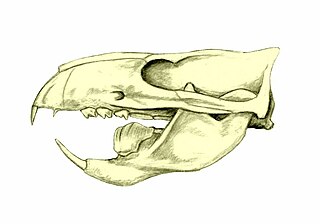
Stratus clouds are low-level clouds characterized by horizontal layering with a uniform base, as opposed to convective or cumuliform clouds formed by rising thermals. The term stratus describes flat, hazy, featureless clouds at low altitudes varying in color from dark gray to nearly white. The word stratus comes from the Latin prefix strato-, meaning "layer". Stratus clouds may produce a light drizzle or a small amount of snow. These clouds are essentially above-ground fog formed either through the lifting of morning fog or through cold air moving at low altitudes. Some call these clouds "high fog" for their fog-like form.

Ptilodus is a genus of mammals from the extinct order of Multituberculata, and lived during the Paleocene in North America.

Xenosauridae is a family of anguimorph lizards whose only living representative is the genus Xenosaurus, which is native to Central America. Xenosauridae also includes the extinct genera Exostinus and Restes. Also known as knob-scaled lizards, they have rounded, bumpy scales and osteoderms. Most living species prefer humid, rocky habitats, although they are widespread within their native regions, with some inhabiting semi-arid scrub environments. They are carnivorous or insectivorous, and give birth to live young.

Xenosaurus is a genus of lizards; it is the only extant genus in the family Xenosauridae, with 14 species currently recognized. Also known as knob-scaled lizards, they can found in southwestern Tamaulipas and eastern Guerrero in Mexico. These lizards are known to feed on a variety of crawling and flying insects. This genus mostly eats orthopterans, coleopterans (beetles), dipterans, and myriapods.

Xenosaurus rectocollaris, sometimes known as the pallid knob-scaled lizard, is a species of viviparous lizard. It is endemic to Mexico where it is known from the Sierra Madre de Oaxaca of Oaxaca and Puebla states. It is a rare species occurring in rock crevices in pristine semi-arid areas.

Xenosaurus grandis, commonly known as the knob-scaled lizard, is a species of diurnal, terrestrial lizard endemic to Mexico and Guatemala. It primarily inhabits tropical rainforests. It dwells in rock crevices and eats insects.

Fractus clouds, also called fractostratus or fractocumulus, are small, ragged cloud fragments that are usually found under an ambient cloud base. They form or have broken off from a larger cloud, and are generally sheared by strong winds, giving them a jagged, shredded appearance. Fractus have irregular patterns, appearing much like torn pieces of cotton candy. They change constantly, often forming and dissipating rapidly. They do not have clearly defined bases. Sometimes they are persistent and form very near the surface. Common kinds include scud and cloud tags.

Pannus, or scud clouds, is a type of fractus cloud at low height above ground, detached, and of irregular form, found beneath nimbostratus, cumulonimbus, altostratus and cumulus clouds. These clouds are often ragged or wispy in appearance. When caught in the outflow (downdraft) beneath a thunderstorm, scud clouds will often move faster than the storm clouds themselves. If the parent cloud that scud clouds pair with were to suddenly dissipate, the pannus cloud accessory would not be able to be told apart from a fractus cloud formation.

Luperosuchus is an extinct genus of loricatan pseudosuchian reptile which contains only a single species, Luperosuchus fractus. It is known from the Chañares Formation of Argentina, within strata belonging to the latest Ladinian stage of the late Middle Triassic, or the earliest Carnian of the Late Triassic. Luperosuchus was one of the largest carnivores of the Chañares Formation, although its remains are fragmentary and primarily represented by a skull with similarities to Prestosuchus and Saurosuchus.
Mirosternus fractus is a species of beetle in the family Ptinidae.

Xenosaurus platyceps, the flathead knob-scaled lizard, is a lizard found in the Sierra Madre Oriental of Mexico. Its natural habitat is dry scrub forest and oak savanna. The species is endangered due to habitat fragmentation for the development of tourism and agriculture as well as predation by feral cats. Currently, the flathead knob-scaled lizard does not live in a protected area.
Carusioidea is a clade of lizards that includes the family Xenosauridae from Central America and the extinct genus Carusia from the Late Cretaceous of Mongolia. It was named in 1998 after a sister-group relationship was found between Carusia and Xenosauridae. Phylogenetic analysis indicates that Carusioidea is the most basal clade within Anguimorpha. Features that help define Carusioidea include closely spaced orbits or eye sockets separated by fused frontal bones, a connection between the jugal and squamosal bones below the supratemporal arch, and a covering of bony osteoderms over the skull roof. Below is a cladogram showing the phylogenetic relationships of carusioids from Gao and Norell (1998):
Pimus fractus is a species of hacklemesh weaver in the spider family Amaurobiidae. It is found in the United States.
Xenosaurus agrenon, the mountain knob-scaled lizard, is a lizard found in Oaxaca of Mexico.

Xenosaurus mendozai is a lizard found in Mexico.
Xenosaurus newmanorum, Newman's knob-scaled lizard, is a lizard found in Mexico.
Xenosaurus penai, Pena's knob-scaled lizard, is a lizard found in Mexico.

Xenosaurus phalaroanthereon, the chin-spotted knob-scaled lizard, is a lizard found in Mexico.
Xenosaurus rackhami, Rackham's knob-scaled lizard, is a lizard found in Mexico and Guatemala.
Xenosaurus tzacualtipantecus, the Zacualtipá́n knob-scaled lizard, is a lizard found in Mexico.









